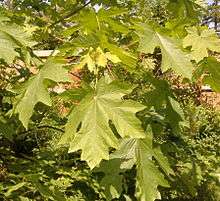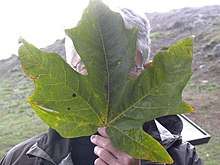Acer macrophyllum
Acer macrophyllum, the bigleaf maple[3] or Oregon maple,[4] is a large deciduous tree in the genus Acer.
| Acer macrophyllum | |
|---|---|
 | |
| Bigleaf maple foliage | |
| Scientific classification | |
| Kingdom: | |
| (unranked): | |
| (unranked): | |
| (unranked): | |
| Order: | |
| Family: | |
| Genus: | |
| Species: | A. macrophyllum |
| Binomial name | |
| Acer macrophyllum Pursh 1813 | |
 | |
| Natural range | |
| Synonyms | |
|
List
| |
Big Leaf Maple can grow up to 157.80 feet (48.10 m) tall,[5][6] but more commonly reaches 15–20 m (50–65 ft) tall. It is native to western North America, mostly near the Pacific coast, from southernmost Alaska to southern California. Some stands are also found inland in the foothills of the Sierra Nevada mountains of central California, and a tiny population occurs in central Idaho.[3][7][8]

Description
Big Leaf Maple has the largest leaves of any maple, typically 15–30 cm (5.9–11.8 in) across, with five deeply incised palmate lobes, with the largest running to 61 centimetres (24 in).[9][10] In the fall, the leaves turn to gold and yellow, often to spectacular effect against the backdrop of evergreen conifers.
The flowers Big Leaf Maple produces in spring in pendulous racemes 10–15 cm (4–6 in) long, greenish-yellow with inconspicuous petals. The fruit is a paired winged samara, each seed 1–1.5 centimetres (3⁄8–5⁄8 in) in diameter with a 4–5-centimetre (1 5⁄8–2-inch) wing.[7][10][9]
In the more humid parts of its range, such as in the Olympic National Park, Big Leaf Maple's bark is covered with epiphytic moss and fern species.
Habitat
Bigleaf maple can form pure stands on moist soils in proximity to streams, but are generally found within riparian hardwood forests or dispersed, (under or within), relatively open canopies of conifers, mixed evergreens, or oaks (Quercus spp.)[11][8] In cool and moist temperate mixed woods they are one of the dominant species.[12] It is very rare north of Vancouver Island though cultivated in Prince Rupert,[13] near Ketchikan and in Juneau.[14]
Ecology and uses
The winged fruits are eaten by squirrels, and by grosbeaks in the winter.[15]
Bigleaf maple has been used for creating syrup but it is not common. This is because sugar maple has a higher sugar content. Nevertheless, syrup production has become a localized industry in bigleaf maple groves where weather conditions (including sub-freezing winters) are especially suitable, such as near sea-level in British Columbia and at higher elevations along the West Coast from Washington through Northern California.
Lumber
Bigleaf maple is the only commercially important maple of the Pacific Coast region.[11]
The wood is used for applications as diverse as furniture, piano frames and salad bowls. Highly figured wood is not uncommon and is used for veneer, stringed instruments, guitar bodies, and gun stocks.
The wood is primarily used in veneer production for furniture, but is also used in musical instrument production, interior paneling, and other hardwood products; the heartwood is light, reddish-brown, fine-grained, moderately heavy, and moderately hard and strong.[16] Native Americans used the wood to make canoe paddles.[17]
In California, land managers do not highly value bigleaf maple, and it is often intentionally knocked over and left un-harvested during harvest of Douglas fir and redwood stands.[18]
Food
Maple syrup has been made from the sap of bigleaf maple trees.[19] While the sugar concentration is about the same as in Acer saccharum (sugar maple), the flavor is somewhat different. Interest in commercially producing syrup from bigleaf maple sap has been limited.[20] Although not traditionally used for syrup production, it takes about 40 volumes of sap to produce 1 volume of maple syrup.
Big Leaf Maple leaves are used as browse by black-tailed deer, mule deer, and horses during the sapling stage.[21]
A western Oregon study found that 60 percent of bigleaf maple seedlings over 10 inches (25 cm) tall had been browsed by deer, most several times.[22]
Big Tree
The current national champion bigleaf maple is located in Lane County, Oregon. It has a circumference of 38.6 feet (11.8 m)—or an average diameter at breast height of about 12.3 feet (3.7 m)—and is 119 feet (36 m) tall with a crown spread of 91 feet (28 m).[23] The previous national champion is located in Marion, Oregon, and has a circumference of 25.4 feet (7.7 m)—or an average diameter at breast height of about 8.1 feet (2.5 m)—and is 88 feet (27 m) tall with a crown spread of 104 feet (32 m).
Cultivars
Gallery
 Acer macrophyllum in early spring
Acer macrophyllum in early spring The 10–15-centimetre (4–6-inch)-long raceme of greenish-yellow flowers appear as the leaves are developing in the spring.
The 10–15-centimetre (4–6-inch)-long raceme of greenish-yellow flowers appear as the leaves are developing in the spring. Moss on Bigleaf maple in Hoh Rainforest in Olympic National Park, Washington
Moss on Bigleaf maple in Hoh Rainforest in Olympic National Park, Washington- Bigleaf maple in the McKenzie River valley in western Oregon
 "WORLD'S LARGEST BIGLEAF MAPLE" IN ENGLISH CAMP on San Juan Island, Washington
"WORLD'S LARGEST BIGLEAF MAPLE" IN ENGLISH CAMP on San Juan Island, Washington Fallen Acer macrophyllum leaf in fall near Cashmere, Washington
Fallen Acer macrophyllum leaf in fall near Cashmere, Washington
References
- "Acer macrophyllum". IUCN Red List of Threatened Species. 2019. 2019. Retrieved 16 June 2019.CS1 maint: ref=harv (link)
- http://online.sfsu.edu/bholzman/courses/Fall01%20projects/acermac.htm
- "Acer macrophyllum". Natural Resources Conservation Service PLANTS Database. USDA. Retrieved 6 January 2016.
- "BSBI List 2007". Botanical Society of Britain and Ireland. Archived from the original (xls) on 2015-01-25. Retrieved 2014-10-17.
- Vaden, M. D. "World's Tallest Maple Discovery of 2012".
- Poor, Kasi (2012-11-06). "The tall tale of 'Humboldt Honey' -- tree hunter says world's tallest maple is in Humboldt Redwoods State Park". Times-Standard. Archived from the original on 2013-12-03. Retrieved 2012-11-10.
- Klinkenberg, Brian (Editor) (2014). "Acer macrophyllum". E-Flora BC: Electronic Atlas of the Plants of British Columbia [eflora.bc.ca]. Lab for Advanced Spatial Analysis, Department of Geography, University of British Columbia, Vancouver. Retrieved 2015-02-07.CS1 maint: extra text: authors list (link)
- Sullivan, Steven. K. (2015). "Acer macrophyllum". Wildflower Search. Retrieved 2015-02-07.
- Giblin, David (Editor) (2015). "Acer macrophyllum". WTU Herbarium Image Collection. Burke Museum, University of Washington. Retrieved 2015-02-07.CS1 maint: extra text: authors list (link)
- Whittemore, Alan T. (2012). "Acer macrophyllum". In Jepson Flora Project (ed.). Jepson eFlora. The Jepson Herbarium, University of California, Berkeley. Retrieved 2015-02-07.
- Fryer, Janet L. (2011). "Acer macrophyllum". Fire Effects Information System (FEIS). US Department of Agriculture (USDA), Forest Service (USFS), Rocky Mountain Research Station, Fire Sciences Laboratory – via https://www.feis-crs.org/feis/.
- Wilson, Bert (2014). "Mixed Evergreen Forest". Nature of California. Las Pilitas Nursery.
- "Trees of Prince Rupert" (blog). 2010.
- "Trees Near Their Limits -- Alaska" (blog). 2010.
- Peattie, Donald Culross (1953). A Natural History of Western Trees. New York: Bonanza Books. pp. 606–07.
- Arno, Stephen F.; Hammerly, Ramona P. (1977). Northwest trees. Seattle, WA: The Mountaineers.
- Whitney, Stephen (1985). Western Forests (The Audubon Society Nature Guides). New York: Knopf. p. 395. ISBN 0-394-73127-1.
- Bolsinger, Charles L. (1988). "The hardwoods of California's timberlands, woodlands, and savannas". Resource Bulletin PNW-RB-148. Portland, OR: United States Department of Agriculture, Forest Service, Pacific Northwest Research Station.
- Ruth, Robert H.; Underwood; J. Clyde; Smith, Clark E.; Yang, Hoya Y. (1972). "Maple sirup production from bigleaf maple" (PDF). PNW-181. Portland, OR: U.S. Department of Agriculture, Forest Service, Pacific Northwest Forest and Range Experiment Station.
- "Maple syrup" (PDF). Island Net. Archived from the original (PDF) on September 25, 2006.
- Fowells, H. A., ed. (1965). Silvics of forest trees of the United States. Agric. Handb. 271. Washington, DC: U.S. Department of Agriculture, Forest Service.
- Fried, Jeremy S.; Tappeiner, John C.; Hibbs, David E. (1988). "Bigleaf maple seedling establishment and early growth in Douglas-fir forests". Canadian Journal of Forest Research. 18: 1226–1233. doi:10.1139/x88-189.
- "Bigleaf Maple (Acer macrophyllum)". National Register of Big Trees. American Forests.
- http://plants.gardenworks.ca/11190002/Plant/5823/Mocha_Rose_Big_Leaf_Maple
- http://www.bamboobotanicals.ca/html/japanese-maples/acer-macrophyllum-santiam-snows.html
External links

- Calflora
- photo of herbarium specimen at Missouri Botanical Garden, collected in Yolo County, California, in 1903
